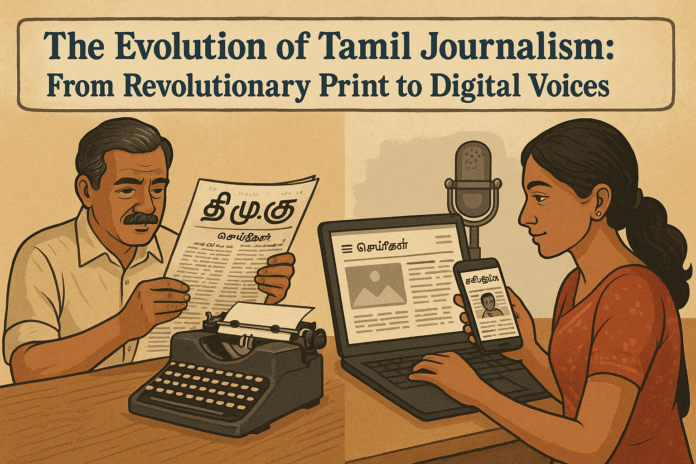The Evolution of Tamil Journalism: From Revolutionary Print to Digital Voices
Tamil Nadu has a long, vibrant, and transformative history of journalism that intertwines deeply with the state’s social, political, and cultural awakening. From the fiery print publications of the colonial period to the tech-driven digital media houses of today, Tamil journalism has evolved as both a mirror and a motor of change. It has nurtured reformers, questioned authority, strengthened the Dravidian movement, and now powers digital activism and citizen-led narratives.
📜 Early Roots: Tamil Journalism in the Colonial Era
The origins of Tamil journalism can be traced back to the early 19th century under British colonial rule. The first Tamil newspaper was “Swadesamitran” launched in 1882 by G. Subramania Iyer, who also co-founded The Hindu. Written in a simple style, it was created to reach the common people and spread nationalist ideas.
Other prominent early papers include:
- Desabhimani (1878): A pro-nationalist paper advocating social reforms.
- India (1897): Run by Subramania Bharati, this fiery journal promoted nationalism, women’s emancipation, and caste equality.
- The Hindu (1878): Though in English, it had Tamil editions and heavily influenced Tamil political thought.
These papers laid the foundation for a journalism that was not just informative but activist in nature—a legacy still strong in Tamil Nadu.
🗞 The Role of Journalism in Social & Political Reform
Tamil journalism became a key tool in mobilizing public opinion during:
- Anti-colonial struggles
- The Self-Respect Movement (led by Periyar E.V. Ramasamy)
- Dravidian political ideologies in the 20th century
Publications like “Kudi Arasu”, started by Periyar in 1925, were instrumental in questioning Brahminical orthodoxy, caste discrimination, and religious dogma. Tamil newspapers became vehicles for political mobilization, social justice, and rationalist thinking, significantly influencing the Dravidian political parties that dominate Tamil Nadu’s politics to this day.
📺 Expansion into Television and Multimedia
The post-liberalization era saw Tamil journalism expanding from print to television and radio, with channels like:
- Sun News
- Puthiya Thalaimurai
- Jaya TV
- Thanthi TV
- Kalaignar TV
These outlets delivered 24/7 news cycles in Tamil, making journalism more immediate and visually impactful. TV debates, election coverage, and political satire gained mass popularity, with anchors and journalists becoming public figures.
📱 The Digital Turn: Rise of New-Age Tamil Journalism
In the 2010s, Tamil journalism witnessed a digital explosion:
- YouTube news channels like Chanakyaa, Valaipechu, Red Pix, and Sattai Durai Murugan became household names.
- WhatsApp groups, Telegram channels, and Facebook Live streams began delivering real-time updates to rural and urban audiences alike.
- Citizen journalists started emerging from even small towns and districts, reporting hyperlocal issues through mobile phones.
This digital democratization allowed marginalized voices—Dalits, women, farmers, and activists—to find a platform outside mainstream media, which was often tied to corporate or political interests.
🏅 Notable Tamil Journalists and Thought Leaders
Tamil Nadu has produced several eminent journalists and editors who shaped public opinion:
- G. Subramania Iyer: Founding editor of The Hindu and Swadesamitran, a champion of reformist journalism.
- Subramania Bharati: Poet, freedom fighter, and editor who redefined Tamil journalism with firebrand prose and poetry.
- Cho Ramaswamy: Editor of Thuglak, known for his sharp political satire and fearless criticism of politicians.
- Gnani Sankaran: A rationalist writer and critic known for his bold columns and TV presence.
- N. Ram: Former editor of The Hindu, who upheld investigative journalism and editorial independence.
🎯 Challenges and the Road Ahead
Despite the rich legacy, Tamil journalism today faces:
- Corporate and political ownership of media houses
- Decline of editorial independence in some outlets
- Spread of misinformation and lack of fact-checking online
- Cyber harassment of female journalists
- Legal threats and defamation suits against critical voices
However, the emergence of independent digital news platforms, student-led media, and fact-checking initiatives show promise.
🛡Role of Bharat Media Association (BMA)
To preserve Tamil Nadu’s bold media culture, Bharat Media Association (BMA) supports journalists by:
- Offering legal aid and training in ethical journalism
- Recognizing independent and rural voices
- Creating platforms for fair, fearless, and factual reporting
- Promoting Tamil language media and new-age storytelling
✅ Conclusion
Tamil Nadu’s journalism has evolved from being a voice of resistance in the colonial era to a digitally empowered force for truth, justice, and accountability. Rooted in the Dravidian ethos and reformist spirit, Tamil journalism continues to shape public consciousness and inspire new generations of storytellers.









